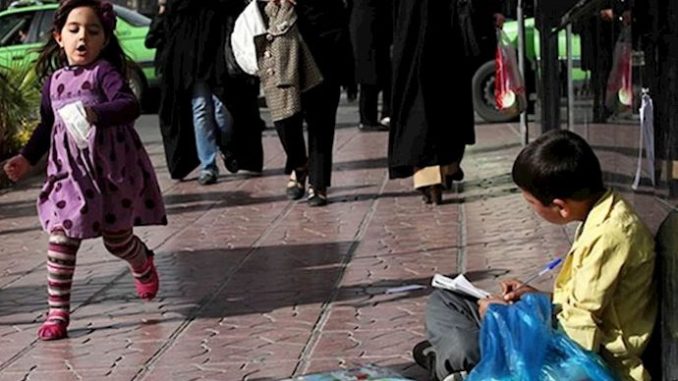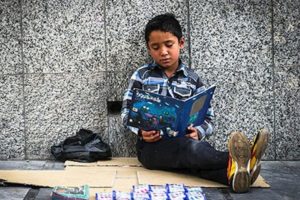High Cost of Education Threatens Future of Iran’s Children

The high cost of education including high prices of stationery in Iran is depriving many students of going to school and these students are eliminated from the cycle of education early as their families cannot afford the costs.
Ali Khodaei, an Iranian regime’s official in labor affairs, admits: “The prices of all necessary items for families have suddenly escalated, and in this situation, school fees can lead to dangerous consequences.”
He told state-run ILNA news agency on September 22: “Red alerts are on, for months; it is not unexpected that many students and especially girls to drop out of school if the government does not allocate enough budget for education of labor-class families.”
This pressure on families for paying school fees appears after the denial of the Ministry of Education from providing the schools’ budget. Moreover, people are struggling with the rising price of stationery.
People are crying out against the high cost of living
In a video clip widely distributed in social media, a lady talks about the high cost of stationery: “I went to buy some stationery yesterday and it cost me 8,000,000 rials. I was shocked! School books cost me 200,000 rials! Stationery cost me 3,000,000 rials and a backpack 3,000,000 rials. This is the situation in our country.” She also added, “Some notebooks, pens and color pencils cost 3,000,000 rials, and some school books 1,200,000 rials.”
In recent times, prices have increased by 100 percent and families cannot afford the costs. Purchasing items from the market decreased by 50 percent and if a family could but 10 notebooks last year, they just can buy 5 this year.
On September 14, state-run news agency Tasnim aired a report about the unexpected cost of stationery in the northern province of Mazandaran. In this report, a buyer talks about the inability of people to buy goods: “The ability of people has decreased and the prices have increased; so families cannot provide necessities for their children.” “The price of stationery has increased by 100 percent, however, it cannot be found in the market” the buyer added. “There is no foreign-made stationery at all, and the domestic goods are of low quality. However domestic goods are resuming an ascending trend. We were selling a pencil for 5,000 rials, but now we have to buy it for 7,000!” a shopkeeper complains.
People in Gilan province, northern Iran, are crying out for the same reason. Highlighting the increasing prices compared to the last year, a buyer described the situation as saying: “There is a blatant difference between the prices year on year. We could buy the same items at half the price. They (governmental officials) told us that we can find proper prices in the state-run market, but the prices there were also doubled.”
Rising education fees have forced some families to send just one of their children to the school as they cannot afford the cost of education for all of their family.
Shocking figures of education dropouts
The regime’s corrupt policies and rising prices are forcing students to drop out or school at an accelerating pace.

The state-run newspaper, Jahan-e San’at, issued shocking figures in this regard on September 23, 2018: “The number of children deprived of education is approximately 7 million in Iran.”
The report added, “Out of every 3 Iranian youth aged 6-18, one has either quit education or has not enrolled at all.”
This is while many children in far-off regions have no access to any schools, in addition to the above-mentioned problems.
This is how the poor Iranian children are deprived of their right to education and end up into street peddling, working as child labor or become street children with no right to livelihoods and dignity and drowned in social crisis.
Under the rule of the mullahs in Iran, the children’s rights are not comparable with the U.N. Convention on the Rights of the Child
What Iranian children are enjoying is in total contrast to what they’re entitled to according to the Convention on the Rights of the Child that states:
Article 28
1. States Parties recognize the right of the child to education, and with a view to achieving this right progressively and on the basis of equal opportunity, they shall, in particular:
(a) Make primary education compulsory and available free to all;
(b) Encourage the development of different forms of secondary education, including general and vocational education, make them available and accessible to every child, and take appropriate measures such as the introduction of free education and offering financial assistance in case of need;
(c) Make higher education accessible to all on the basis of capacity by every appropriate means;
(d) Make educational and vocational information and guidance available and accessible to all children;
(e) Take measures to encourage regular attendance at schools and the reduction of drop-out rates.
2. States Parties shall take all appropriate measures to ensure that school discipline is administered in a manner consistent with the child’s human dignity and in conformity with the present Convention.
3. States Parties shall promote and encourage international cooperation in matters relating to education, in particular with a view to contributing to the elimination of ignorance and illiteracy throughout the world and facilitating access to scientific and technical knowledge and modern teaching methods. In this regard, particular account shall be taken of the needs of developing countries.
Article 29
1. States Parties agree that the education of the child shall be directed to:
(a) The development of the child’s personality, talents and mental and physical abilities to their fullest potential;
(b) The development of respect for human rights and fundamental freedoms, and for the principles enshrined in the Charter of the United Nations;
(c) The development of respect for the child’s parents, his or her own cultural identity, language, and values, for the national values of the country in which the child is living, the country from which he or she may originate, and for civilizations different from his or her own;
(d) The preparation of the child for responsible life in a free society, in the spirit of understanding, peace, tolerance, equality of sexes, and friendship among all peoples, ethnic, national and religious groups and persons of indigenous origin;
(e) The development of respect for the natural environment.
2. No part of the present article or article 28 shall be construed so as to interfere with the liberty of individuals and bodies to establish and direct educational institutions, subject always to the observance of the principle set forth in paragraph 1 of the present article and to the requirements that the education given in such institutions shall conform to such minimum standards as may be laid down by the State.
In Iran, however, the condition of 7 million children that was mentioned in Jahan-e San’at newspaper is the exact opposite of what the two articles are calling for.
It is worth mentioning that, according to principle 30 of the Iranian regime’s constitution, education in Iran must be free for all students below the university level.
However, the fact is that the regime has left no right for the Iranian people including children. The regime is neither committed to its own constitution nor to international conventions.
All these happen while Tehran allocates billions of dollars to its proxies in Lebanon, Syria, Iraq, and Africa to export terrorism and fundamentalism. Meanwhile, Iran’s future generation lack schools, education, and their most basic needs.












No comments:
Post a Comment